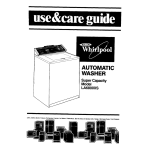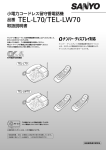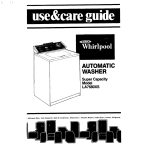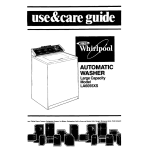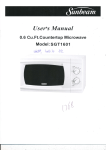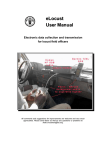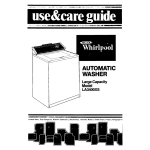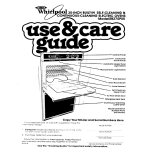Download Whirlpool LA609OXS Operating instructions
Transcript
AUTOMATIC WASHER Super Capacity Model LA609OXS lcrowave Ovens. Trash Compactors, Room AM Conditioners. tlehum~d~fiers. Automatic Washers. Clothes Dryers, freezers. Relrlgerator-F Contents Page Paae PARTS AND FEATURES IMPORTANT SAFETY INSTRUCTIONS. OPERATING INSTRUCTIONS.. Starting Your Washer What Happens in Each Cycle OTHER OPERATING INSTRUCTIONS.. EXTRA RINSE OPTION For a Rinse and Spin For a Drain and Spin For a Soak or Pre-Wash Liquid Bleach Dispenser Fabric Softener Dispenser MAGIC CLEAN’” Lint Filter CARING FOR YOUR WASHER Winterizing IF YOU NEED SERVICE OR ASSISTANCE . WASHER WARRANTY.. 2 3 4 4 6 12 12 12 ,61987 Whirlpool 12 13 13 14 14 15 16 :i Corporation Parts and features LOAD SIZE LAUNDRY INFORMATION CYCLE CONTROL EXTRA RINSE MAGIC CLEAN @ LINT FILTER (not shown] LIQUID FABRIC SOFlENER DISPENSER Remove the Consumer Buy Guide label. It will be easier to remove before the washer is used. You should wipe out the basket with a damp cloth before using to remove dust from storing or shipping. Copy your Model and Serial Numbers here When you need service or call with a question, have this information ready: Model Number 1. Complete Model and Serial Numbers serio, Number (from plate under the lid near the hinge]. 2. Purchase date from sales slip. PurchoseDate Copy this information in these spaces. Keep this book, your”Laundry Guide” and sales slip in the Laundry Information Service Company Center. Phone Number Please complete and mail the Owner Registration Card furnished this product. with Additional Safety Instructions ALWAYS store detergent, laundry aids and other materials in a cool, dry place where children can’t reach them- in a locked cabinet if possible. ALWAYS read and follow instructions on packages of detergent and laundry aids - especially warnings and precautions. HAZARDOUS FUMES can be formed if chlorine bleach is used in the same wash as ammonia or acids such as vinegar or rust remover. and Your Responsibilities ALWAYS unplug the power supply cord before attempting to service the washer. DO NOT machine wash glass fiber materials. Small particles can stick to fabrics washed in following loads and cause skin irritation. You are personally responsible for making sure that your washer: l is used only for jobs normally expetted of home automatic washers. l is not run by children or anyone unable to operate it properly. 3 Operating instructions Starting Your Washer Be sure to measure and add detergent, then place a sorted load in the washer before starting it. 1 . Select l l l 2. a LOAD SIZE Turn the knob to point at a setting that describes the size of load you want to wash. Set the knob anywhere on or between EX SMALL (a few small items) and EX LARGE (a full load). To change the water level after the washer has started to fill, turn the knob to RESET,then the desired water level. l l Select WATER TEMPERATURES Select wash and rinse water temperatures by pushing a button. This drawing shows a warm wash (top temperature] and cold rinse (bottom temperature) selection. Recommended wash temperatures can be found in your “Laundry Guide:’ LOAD SIZES AND WATER LEVELS For best cleaning results, load must be able to move in the water. Too big a load little water can cause wear tearing of load items. *Approximate fill with load. 4 the freely or too or 8 CAUTION: DO NOT OVERLOAD WASHER. EX LARGE (21.7 gals./82.1 L)’ MEDIUM (16.4 galsJ62.1 L)’ EX SMALL (11.9 gals./450 L)’ 3. Start the washer A. Push in the Control Knob and turn it to the right. It must be pushed in and turned only clockwise. C. Start the washer by pulling out B. Stop on a number in the cycle you want. The numbers are minutes of wash time. The drawing shows 10 minutes of agitation in the REGULARNORMAL Cycle. D. To stop the washer at any time, the Control Knob. The washer will push in the Control Knob. To fill to the level you set with wash water of the selected temperature. After filling, the washer will agitate for the selected number of minutes. restart the washer, pull out the Control Knob. What Happens in Each Cycle* Each cycle has different agitation and spin speeds designed for different kinds of fabrics. Numbers on the dial in each cycle are the minutes of WASH agitation time. When the Cycle Control Knob is set to a number and pulled out, the washer fills before agitation and timing starts, After agitation starts, the knob turns clock-wise until it points to OFF and the cycle ends. REGULAR HEAVY Cycle DRAIN No Agitation A cycle for sturdily constructed fabrics that are heavily soiled. REGULAR NORMAL Cycle A cycle for regular loads of fabrics that are moderately soiled. PERMANENT PRESS NORMAL Cycle q REFILL A cycle designed for permanent press and some synthetic fabrics that are moderately soiled. The cool-down rinse helps keep wrinkles from setting into these items. 6 COOL DOWN l- NOTE: You may hear the sound of wafer spraying during the spin parts of some cycles. In some cycles, cold wafer is sprayed on the spinning load to help with the rinsing. Gentle Wash System For better fabric care in the REGULAR and PERMANENT PRESS cycles, agitation speed is reduced during the last few minutes of wash time. rl WASH Low Speed NOTE: Always for permanent use cold rinse water press fabrics. the PERMANENT PRESS LIGHT Cycle pI$z&q,~ REFILL A cycle designed for lightly soiled permanent press and some synthetic fabrics. The cool-down rinse helps keep wrinkles from setting info these items. COOL ElDOWN 1 Cycle ~~~~~~~, A lndlcates the machine Is pausing for a brief soak perlod. A cycle that gently washes and spins moderately soiled delicate items and washable knits. KNITS/GENTLE LIGHT Cycle ~~~~~@g A cycle that gently washes and spins lightly soiled delicate items and washable knits. A Indicates the machine is pauslng for a brief soak period. L SPIN LOW 1 Speed 1 Spray Rinse n WASH Low Speed NOTE: Always for permanent use cold rinse water press fabrics. SOAK and PRE-WASH Cycles Brief periods of agitation and soak time help remove heavy soils and certain stains that need extra pretreatment. Use recommended amount of detergent or presoak additive. The SOAK Cycle should always be followed by a Wash Cycle. WASH 2 Minutes High Speed SUPER WASH Cycle Use for washing heavily soiled loads that require maximum soil removal. Double the amount of detergent recommended when using the SUPER WASH Cycle. 10 n FILL to Selected Level WASH 4 Minutes High Speed I Pre-wash setting begins [see page 12). here, Special care is needed when soaking See your “Laundry Guide” for proper or pre-washing laundry. use of this cycle. Other operating instructions Extra rinse option (automatic) For a rinse and spin (manual) For an automatic extra rinse in the REGULAR HEAVY or REGULAR NORMAL Cycles: l Flip the Extra Rinse button to the “ON” position before the REGULAR Cycle starts. The washer will automatically proceed into the extra rinse and spin after the REGULAR Cycle. You may need an extra rinse and spin for heavily soiled loads which need more detergent. (Extra detergent can require an extra rinse.) 1. Push Control Knob in. 2. Turn clockwise to any l on the dial. See above drawing. 3. Pull Control Knob out. The washer will fill to selected level; agitate 2 If no extra rinse and spin is wanted in minutes; drain and spin. a REGULAR Cycle, make sure the button is in the “OFF” position. For an extra rinse in other cycles, see “For a rinse and spin:’ For a drain and spin For agitation 12 and spin speeds in each cycle, see pages 6-11. For a soak or pre-wash For best results, use warm water for soaking or pre-washing stained laundry. Hot water can set stains. 1. Use recommended amount of detergent or pre-soak product. 2. Push Control Knob in. 3. Turn clockwise to point at a number in the SOAK Cycle. Use the 4 minute mark for a pre-wash? 4. Pull Control Knob out. The washer will start. 5. When the cycle is over, add detergent for the next selected wash cycle. The SOAK Cycle should always be followed by a Wash Cycle. Important: lntormation Guide!’ See additional in your “Laundry ‘To start soak or pre-wash with agitation, the Control must point to a number in the SOAK Cycle. care Knob Liquid bleach dispenser Always measure bleach. Do not guess. Never use more than 1 cup (250 ml) for a full load. Use less with lower water level settings. Follow directions on bottle for safe use. Use a cup with a pouring spout to avoid spilling. 1. Load the washer first. 2. Pour measured bleach carefully into dispenser. DO NOT let bleach splash, drip or run down into the washer basket. Undiluted bleach will damage any fabric it touches. 3. Start the washer. Bleach will be diluted automatically during the wash part of the cycle. For more information on bleaching, see your “laundry Guide!’ Liquid fabric softener dispenser 1. Add detergent and load to the basket. 2. Add liquid fabric softener to the dispenser using the amount recommended on the bottle. 3. Avoid dripping or spilling any fabric softener on the load. 4. Dilute fabric softener with hot water. Add enough hot water to fill the dispenser up to the opening. 5. Start the washer, Diluted fabric softener will be added to the load during the deep rinse portion of the cycle. NOTE: Do not stop the washer during this time. If you do, the softener will mix with the remaining soapy wash water. This will cause stains. Do not put detergent in the liquid fabric softener dispenser. 6. If dispenser needs cleaning, flush with hot water. NOTE: Do not wash clothes with dispenser removed. MAGIC CLEAN@ lint filter The lint filter in your washer cleans itself. Collected lint is drained away with the wash and rinse water. If your washer drains into a tub, remove any lint collected in the drain or strainer. 14 Caring for your was;her WHEN NOT WASHING, keep both water faucets turned off, this takes the pressure off the water inlet valve and hoses. AFlER WASHING, use a soft dry cloth to wipe the outside and inside dry. Leave the lid up until the basket is dry. Wipe up spills right away. Spills can dull or damage the finish. REMOVE SHARP OBJECTS such as pins, buckles, etc., from clothes before washing. Close metal zippers. SHARP OR HEAVY OBJECTS should never be put on or in the washer. Check pocket for bolts, nuts, tools, etc SOME PRETREATMENT PRODUCTS can damage washer and dryer dials, consoles and finishes. Do not use these products on or near your washer or dryer. Winterizing Because some water stays in the washer, freezing can cause a lot of damage. If your washer is stored or moved during the cold weather... 8) ,?. _’ 1. Shut off both water faucets. Disconnect and drain water inlet hoses. 2. Put a quart of automotive-type antifreeze in the basket. To use the washer again... 1. Flush water pipes and hoses. 2. Connect hoses to the washer 3. Turn on the water faucets. 3. Set the washer for a DRAIN and SPIN (see page 12). Let it run for about 30 seconds to mix the antifreeze and water. 4. Run the washer through a complete cycle with one cup of detergent to clean out the antifreeze. If you need service or assistance, we suggest you follow these five steps: 1. Before calling for assistance... Performance problems often result from little things you can find and fix yourself without tools of any kind. l If your washer l does not fill: l Have you checked your home’s main fuses or circuit breaker box? Are the water supply hoses kinked? Is the Cycle Control Knob set and pulled out? If your washer does not spin: l Is the lid closed? l Is the power supply cord plugged into a live circuit with the proper voltage? l Have you checked you home’s main fuses or circuit breaker box? If your washer stops during a cycle: Remember, the washer pauses briefly at different times in each cycle. These pauses are normal. l l Is the power supply cord plugged into a live circuit with the proper voltage? “-3 i If your washer fills and drains without running: l Make sure that the Cycle Control Knob is pointing to a number in the cycle. Make sure the drain hose is higher than the water level in the washer. If it isnV: l The washer may seem to be draining during wash and rinse cycles. l Water can siphon out. (See “lnstallation Instructionsl’) l Are both water faucets open? 2. If you need assistance%. Call Whirlpool COOL-LINE? servIce assistance telephone number. Dial free from anywhere in the U.S.: l-800-253-1301 and talk with one of our trained Consultants. The Consultant can instruct you in how to obtain satisfactory operation from your appliance or, if service is necessary, recommend a qualified service company in your area. 3. If you need service?.. Whirlpool has a nationwide network of franchised TECHCARE@ Service Companies, TECH-CARE service technicians are trained to fulfill the product warranty and provide after-warranty service, anywhere in the United States. To locate TECH-CARE service in your area, call our COOL-LINE service assistance telephone number [see Step 2) or look in your telephone directory Yellow Pages under: 18 4. If you have a problem?.. Call our COOL-LINE service assistance telephone number (see Step 2) and talk with one of our Consultants, or if you prefer, write to: Mr. Robert Stanley Division Vice President Whirlpool Corporation 2000 M-63 Benton Harbor, Ml 49022 5. If you need FSP” replacement parts? . . FSP is a registered trademark of Whirlpool Corporation for quality parts. Look for this symbol of quality whenever you need a replacement partforyour Whirlpool appliance. FSP replacement parts will fit right and work right, because they are made to the same exacting specifications used to build every new Whirlpool appliance. ‘If you must call or write, please provide: model number, serial number, date of purchase, and a complete description of the problem. This information is needed in order to better respond to your request for assistance. Notes WHIRLPOOL” AUTOMATIC W-HER WARRANTY LENGTH OF WARRANTY WHIRLPOOL FULL ONE-YEAR WARRANTY From Date of Purchase FSPX replacement parts and repair labor to correct defects in materials or workmanship. Service must be provided by a franchised TECH-CARE’ service company. LIMITED FIVE-YEAR LARRANTY From Date of Purchase FSP replacement case assembly workmanship. LIMITED TEN-YEAR WARRANTY From Date of Purchase FSP replacement of outer tub should it crack, or fail to contain water, due to defective materials or workmanship. WHIRLPOOL WILL PAY FOR parts for any part of gearif defective in materials or WILL NOT PAY FOR A. Service calls to: 1. Correct the installation of the washer, 2. Instruct you how to use the washer. 3. Replace house fuses or correct house wiring or plumbing. B. Repairs when washer is used in other than normal, single-family household use. C. Pick up and delivery. This product is designed to be repaired in the home. D. Damage to washer caused by accident, misuse, fire, flood, acts of God or use of products not approved by Whirlpool. E. Anv labor costs durina the limited warranties. WHIRLPOOL CORPORATION SHALL NOT BE LIABLE FOR INCIDENTAL OR CONSEQUENTIAL DAMAGES. Some states do not allow the exclusion or limitation of incidental or consequential damages so this limitation or exclusion may not apply to you. This warranty gives you specific legal rights, and you may also have other rights which vary from state to state. Outside the United States, a different warranty may apply. For details, please contact your franchised Whirlpool distributor or military exchange. Part No. 3349133 01987 Whirlpool Corporation \utomatlc Washcrs. Clothes Dryers, Freezers. Relrlgerator-Freezers. Printed in U.S.A. Ice Makers. DIshwashers. Bult-In Ovens and Surface Units. Ranges.




















